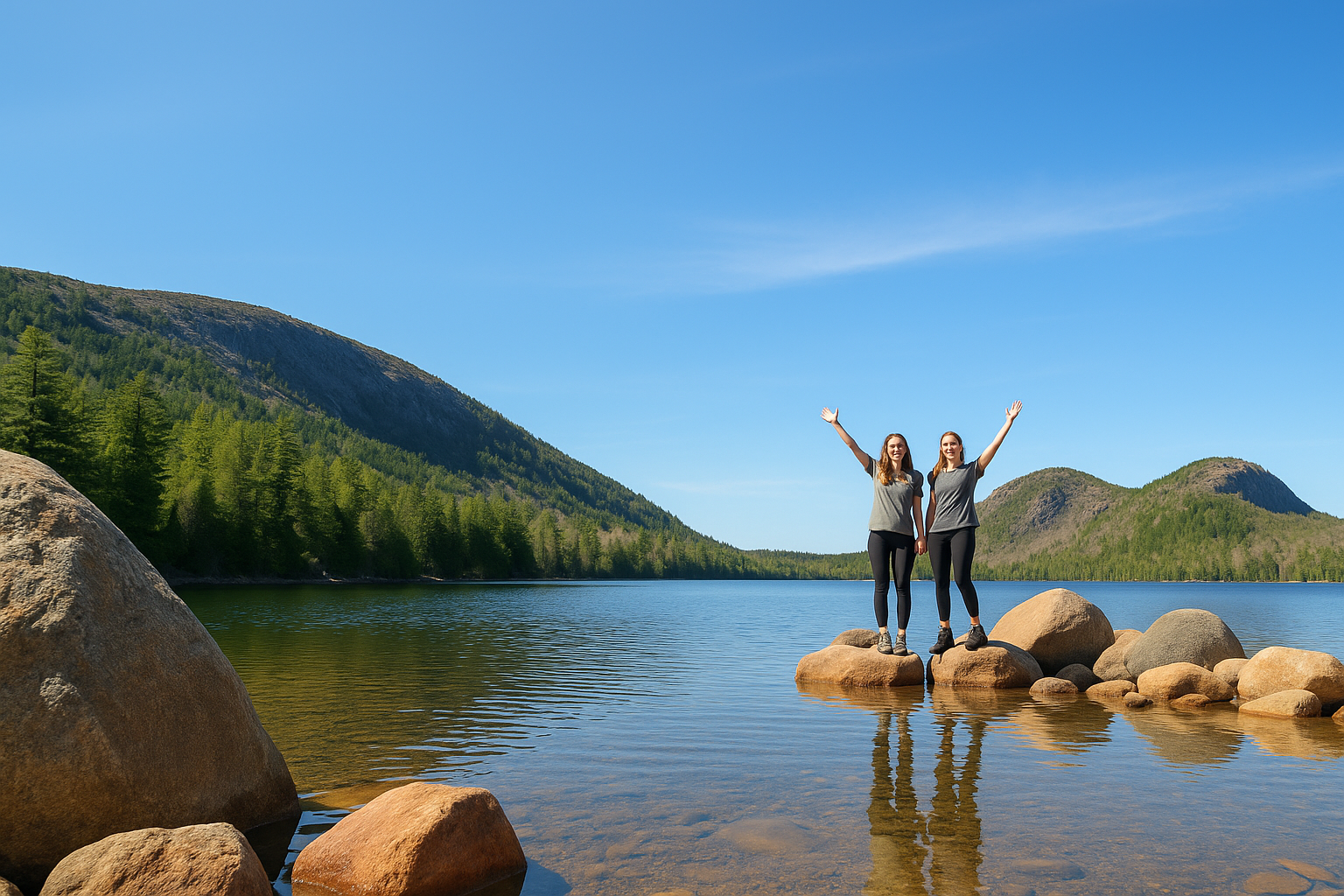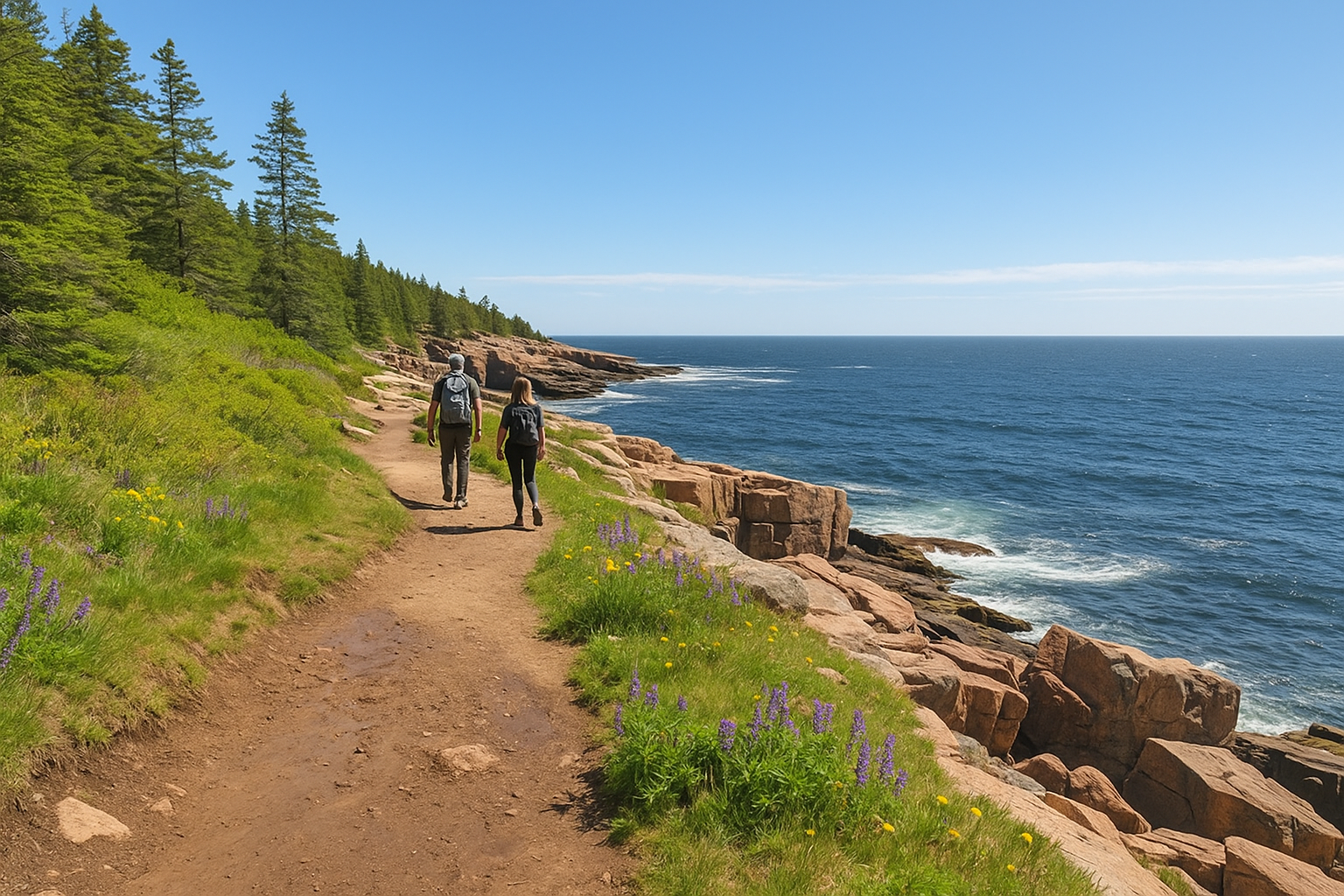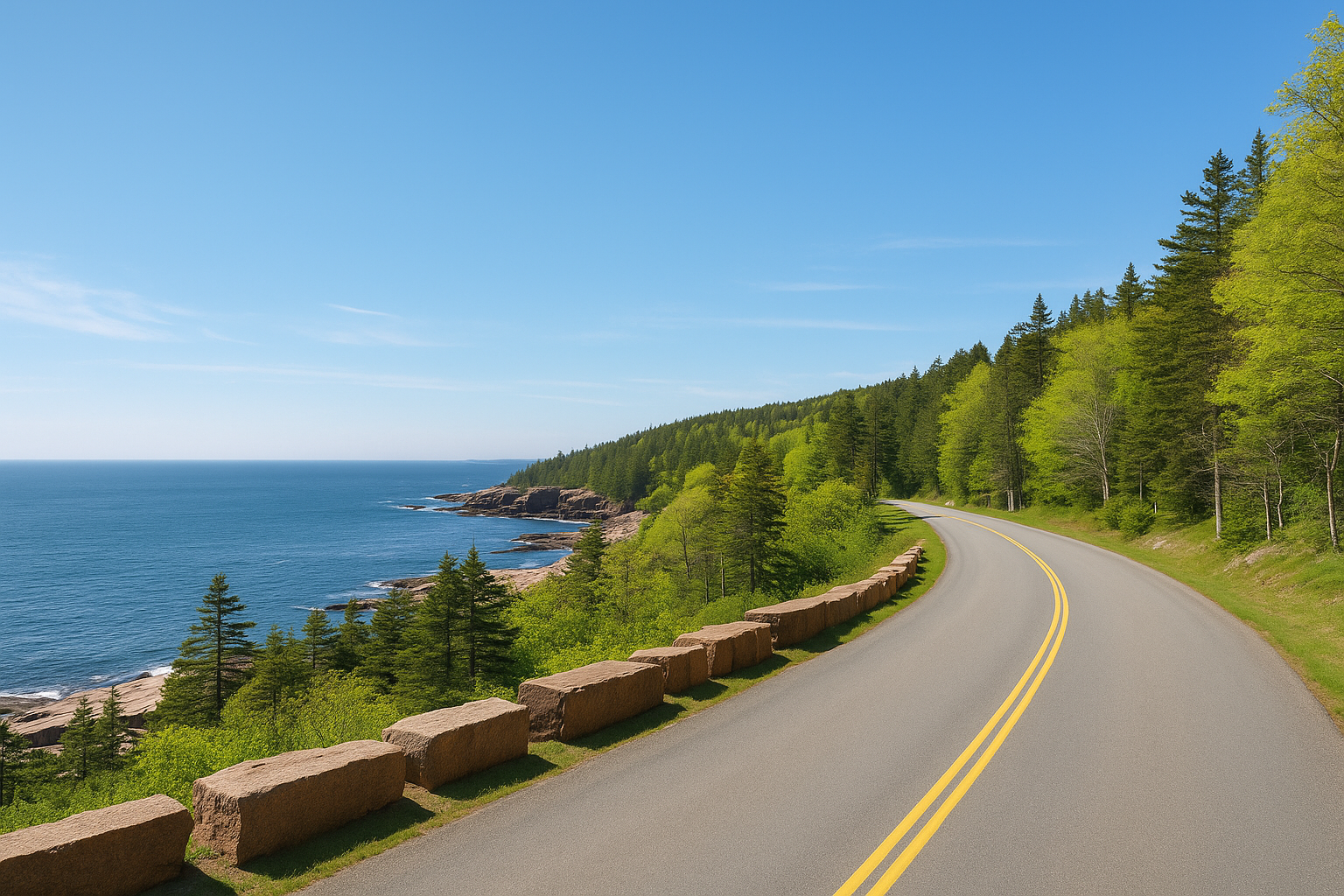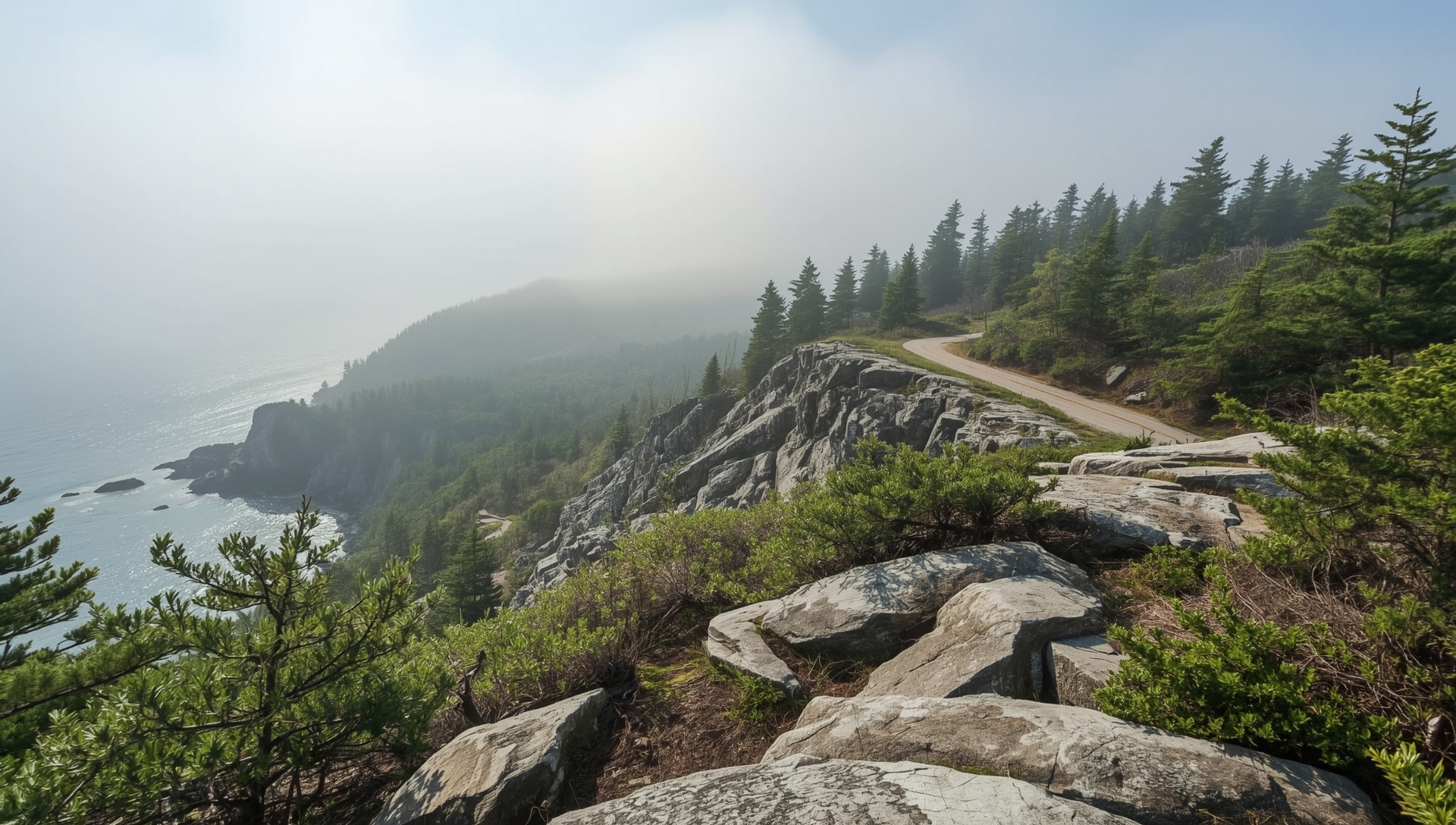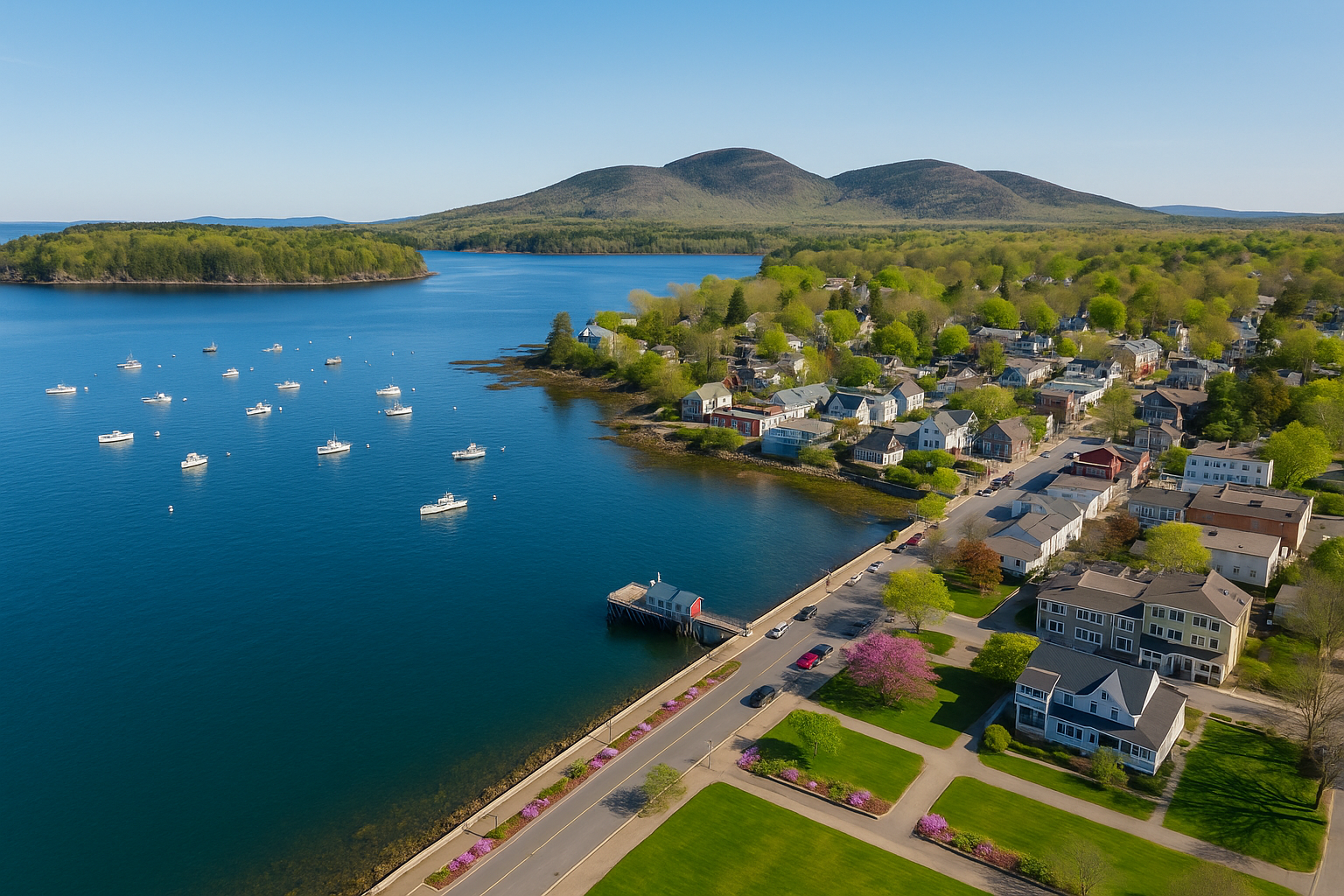Acadia in Spring
A Season of Renewal in Acadia National Park
Acadia in spring is a season of renewal, where every part of the landscape seems to stretch and wake after the long, quiet Maine winter. The forests that stood bare just weeks earlier begin to glow with the fresh greens of new leaves, carpeting the hillsides in a vibrant wash of color. Along trails and open meadows, delicate wildflowers push up through the soil — first shyly, then in great bursts of pink, yellow, and purple that transform the park into a living canvas. The salty ocean breeze carries a crispness that feels both invigorating and calming, a reminder that change is in the air.
For many visitors, Acadia in spring is an unforgettable experience because it balances rugged beauty with a rare sense of peace. This is the season when you can walk along open trails and feel like you have the park to yourself, pausing to listen to the chorus of returning songbirds or to watch sunlight play across still waters. It’s also the perfect time to slow down, breathe deeply, and savor the views without the bustle and crowds that summer inevitably brings. Every step feels like part of a fresh beginning — both for the park and for those who come to explore it.
• Acadia in spring awakens with wildflowers, fresh greenery, and coastal light
• Trails and forests glow with new leaves after the quiet Maine winter
• Ocean breezes carry the scent of salt and pine through blooming meadows
• Perfect time for peaceful hikes, photography, and birdwatching
• Spring in Acadia National Park reveals the gentle beauty of Maine’s changing seasons
Why Visit Acadia in Spring?
From late April through June, Acadia National Park undergoes one of its most remarkable transformations, shifting from icy coastlines and bare trees into a vibrant display of color, sound, and life. After months of snow and silence, the forests begin to hum with activity as streams rush with melted snow, waterfalls swell with new energy, and the first tender leaves shimmer in the sunlight. Wildflowers appear in every clearing, dotting the trails with bursts of pink, yellow, and violet that remind visitors just how alive the park can be. For travelers, Acadia in spring feels like stepping into a place that is both familiar and brand-new — a landscape caught in the middle of rebirth.
One of the biggest draws of visiting during this season is the quiet. Spring is still considered a shoulder season, which means shorter waits at entrance stations, easier parking at trailheads, and scenic overlooks where you can pause without feeling hurried. The park feels slower, calmer, and more personal — a place where you can hear your own footsteps on the path and the soft chatter of birds returning from migration. For those who come to connect with nature rather than crowds, this window of time is a gift.
The landscape itself changes by the week. In early May, snow may linger on the higher peaks, while the lower valleys burst with color and warmth. By June, the hillsides glow in full green, and lupines, violets, and wild blueberry blossoms line the carriage roads and meadows. These early blooms bring the park to life — bees hover in the sunlight, chipmunks scurry through fresh grass, and the scent of pine mixes with the ocean breeze.
For hikers, spring in Acadia is perfect for long, unhurried walks. Temperatures stay cool and comfortable, making it easy to explore for hours — whether circling the mirrored waters of Jordan Pond, tracing the ocean’s edge along Ocean Path, or climbing the granite ridges that define the park’s character. Photographers love this season for its soft light and misty mornings, when fog rolls in from the Atlantic and transforms even familiar views into something magical.
Above all, visiting Acadia in spring means experiencing the park in balance — alive yet peaceful, renewed yet timeless. It’s a chance to slow down, breathe deeply, and see Acadia at its gentlest, just before summer’s energy returns.
• Wildflowers and budding trees add fresh color across the park.
• Bird migrations bring unique species for spotting along the coast and in the forests.
• Cooler temperatures make hiking and wildlife viewing more comfortable.
• Smaller crowds compared to summer mean quieter trails and easier parking.
Hiking in Acadia in Spring
Spring is one of the most rewarding times to experience Acadia’s vast trail network, which stretches over 120 miles across mountains, forests, lakes, and rugged coastline. The crisp, cool air makes every step feel lighter, and with the landscape freshly alive after winter, each path feels like an invitation to explore. The trails seem to hum quietly with renewal — trickling brooks, the rustle of budding leaves, and birds calling from spruce branches still glistening from morning dew. For casual walkers, routes like Jordan Pond Path and Ocean Path are particularly captivating this time of year. The Jordan Pond loop reflects the snow-dusted peaks of The Bubbles in its calm waters, while Ocean Path delivers uninterrupted views of the Atlantic pounding against granite cliffs. On a bright spring day, you can walk for miles with only the rhythmic crash of waves and distant birdsong as your soundtrack.
Every sense awakens when hiking in Acadia in spring. Pine needles release a clean, resinous scent into the warming air, and wildflowers peek out from the edges of the trails — bluets, violets, and the first delicate lady’s slippers. Even the ocean breeze feels different, rolling inland and blending with the earthy perfume of wet granite and soil. It’s an experience that’s both rugged and serene, where every turn reveals something new — a sunlit cove, a quiet patch of moss, or the first chipmunks darting across the path.
For more adventurous hikers, spring offers the ideal conditions for tackling Acadia’s moderate peaks before the heat and crowds of summer arrive. Trails like Day Mountain and Gorham Mountain reward early-season hikers with sweeping coastal panoramas and solitude at the summit. The climb up Day Mountain is especially enjoyable in May and June, with daytime highs between 50–65°F (10–18°C) and a refreshing sea breeze at the top. Even the iconic sunrise hike up Cadillac Mountain feels different in spring, when the air is crisp and the dawn light paints the sky in vivid pinks and oranges, often unobstructed by the haze of summer.
Practical hikers know that spring also brings a few challenges — snowmelt and rain can leave some trails muddy or slick into May. Waterproof boots, trekking poles, and a spare pair of socks can make all the difference. Embracing these small inconveniences is part of the season’s charm: puddles reflect the sky, and the scent of rain on granite lingers in the air. More than any other time of year, spring hiking in Acadia National Park offers space, stillness, and a genuine connection with nature — the feeling that the park is awakening alongside you, one careful step at a time.
Quick Facts – Acadia in Spring
- Season: Late April through June – the park’s most peaceful transition period.
- Average Temps: 40–65°F (4–18°C); cooler mornings and mild afternoons ideal for hiking.
- Best For: Wildflowers, hiking, photography, birdwatching, and quiet scenic drives.
- Park Loop Road: Reopens mid-April (check road conditions before travel).
- Carriage Roads: May remain soft or muddy in early spring – waterproof shoes recommended.
- Wildlife Highlights: Songbirds return in May; seals and eiders visible along the rocky shore.
- Daylight Hours: Expanding rapidly – sunrise around 5:15 a.m., sunset after 7:30 p.m. by late May.
- Tip: Dress in layers, pack waterproof boots, and expect cool sea breezes even on sunny days.
Wildlife in Spring
Just as the forests and fields awaken with new growth, the animals of Acadia return with the warming season, filling the park with movement and sound. For birdwatchers, spring is one of the most thrilling times of year, as Acadia National Park becomes a critical stopover for dozens of migrating species. Warblers flit like sparks of yellow through budding birch trees, loons settle back onto inland lakes with their haunting calls, and peregrine falcons reclaim their nesting cliffs above the coast. On a still morning, the layered chorus of birdsong can feel as vivid as the scenery itself — a soundtrack of renewal that echoes across ponds, valleys, and granite peaks.
Spring also brings the park’s coastline to life. Along the rocky edges of Mount Desert Island, harbor seals haul themselves onto seaweed-covered ledges to bask in the cool sunshine, occasionally lifting their heads as waves crash nearby. Eiders paddle through the surf in tight rafts, their soft, low calls mingling with the sound of distant gulls. In tidepools, crabs scuttle under shifting seaweed, and tiny snails begin their quiet work of reclaiming the rocks. The ocean, which feels stark and quiet in winter, suddenly hums with life again.
Inland, Acadia’s forests and meadows grow just as lively. Red squirrels chatter from pine branches, their voices carrying through the still air, and snowshoe hares — some still half-white from winter — dart through the underbrush with a flash of movement. Chipmunks emerge from burrows to feast on fresh shoots, while frogs fill the wetlands with a rising chorus each evening. Visitors walking the carriage roads or quieter inland trails often notice rustling in the ferns or the quick scurry of small feet crossing their path.
For many travelers, witnessing wildlife in Acadia in spring is one of the most rewarding experiences of the season. It’s not just about spotting animals but seeing the rhythm of renewal — the park itself breathing again after months of rest. Each birdcall, seal splash, or rustle in the woods reminds you that this landscape is alive and changing, responding to the same spring warmth that draws people back year after year. To pause and watch these moments unfold is to feel connected to Acadia’s deeper story — one of endurance, awakening, and quiet wonder.
- Go exploring at dawn or near sunset — wildlife in Acadia is most active during cooler hours.
- Watch for young animals such as fawns, goslings, and playful fox kits near sheltered meadows.
- Bring binoculars for spring bird migrations along the shoreline, ponds, and wetlands.
- Move quietly and stay on marked trails to protect habitats and increase your chances of seeing animals up close.
Driving & Scenic Views
The Park Loop Road, Acadia’s iconic 27-mile scenic drive, usually reopens in mid-April, unlocking access to many of the park’s most famous viewpoints. Driving it in spring feels like rediscovering Acadia at a gentler pace — the roads quiet, the air crisp, and the scenery freshly alive after winter. Gone are the long lines of tour buses and crowded parking lots of midsummer. Instead, visitors find calm stretches of open road where they can stop freely, roll down the windows, and breathe in the clean scent of salt and pine. Each turn reveals the park in transition: new greenery on the hillsides, snowmelt tumbling through roadside streams, and seabirds circling high above the cliffs.
Stops like Sand Beach, Thunder Hole, and Otter Cliffs are especially striking this time of year. With fewer people sharing the viewpoints, it’s easy to linger — to sit on the granite ledges, listen to the rhythmic crash of the surf, and feel the season shifting all around you. The contrast between the cool Atlantic and the emerging spring light creates a mood that’s both peaceful and invigorating. Many travelers say this is when Acadia feels most personal — as though the park has opened just for them.
Further along, smaller pull-offs reveal some of Acadia’s most underrated moments. The short path to Monument Cove offers a quiet place to watch sunlight spill across the water, and the Otter Point overlook rewards patient photographers with dramatic seascapes framed by budding evergreens. Even a brief detour up to Sieur de Monts Spring or the Wild Gardens of Acadia adds a splash of early color, with trillium and bluets blooming along shaded paths.
Spring also delivers some of the clearest skies of the year. A pre-dawn drive up Cadillac Mountain for sunrise is unforgettable — the cold morning air sharpening the horizon into brilliant bands of pink, orange, and gold. On many days, you’ll share the summit with only a few early risers and a gentle wind sweeping across the rocks. For photographers and sightseers alike, driving Acadia in spring is pure reward: fewer crowds, vivid light, and the rare opportunity to experience the park’s legendary views in absolute calm. Every bend in the Park Loop Road feels like the start of something new — the landscape, and the season itself, waking up together.
- Check road status: The Park Loop Road usually reopens in mid-April, but sections may remain closed for maintenance or icy conditions. Verify before your visit.
- Go early or late: Early morning and late afternoon light provide the best photography and the quietest roads.
- Don’t rush: Take time at key stops like Sand Beach, Thunder Hole, and Otter Cliffs — spring crowds are light, so linger.
- Fuel up before entering: There are no gas stations inside the park. Fill your tank in Bar Harbor or Trenton first.
- Bring layers: Even with sunshine, the breeze along coastal overlooks can be chilly.
- Bonus photo stop: Monument Cove glows beautifully in the soft morning light — perfect for spring photography.
Spring Weather in Acadia
Weather in spring can be unpredictable in Acadia National Park, but that’s exactly what makes this season so enchanting. Visitors quickly learn to expect the unexpected — a mix of misty dawns, bright noons, and breezy evenings that can change from moment to moment. Some mornings begin under a soft fog that wraps the mountains in silence, only to lift hours later and reveal brilliant blue skies over Frenchman Bay. Other days start with cool sunshine and end with a light rain shower that turns the park’s granite cliffs darker and more dramatic. Every shift feels like part of the park’s heartbeat, reminding you that Acadia is alive and constantly transforming.
Temperatures in Acadia in spring usually range between 40–65°F (4–18°C), perfect for walking, hiking, and exploring — but the coastal air can make it feel cooler, especially near the water. Dressing in layers is essential. A warm fleece or jacket helps with those early morning starts, a lightweight rain shell is invaluable for mist and drizzle, and breathable clothing underneath keeps you comfortable once the sun breaks through. Mornings on Cadillac Mountain or the exposed cliffs of Otter Point can still carry a winter chill, while afternoons in the valleys feel pleasantly mild.
Snow is generally gone by late April, though shaded sections of trail — especially on the north sides of Day Mountain or Penobscot — can stay damp or icy well into May. As the ground thaws, streams rush with meltwater, filling ponds and waterfalls with a clarity that photographers love. Rain showers, though frequent, tend to pass quickly and leave the park refreshed, the air filled with the scent of pine needles, moss, and the nearby sea.
By mid-May, Acadia’s transformation is unmistakable. Birch and maple trees burst into fresh green, wildflowers open along carriage roads, and sunlight filters through new leaves in soft, golden tones. Days grow longer and evenings stretch past 7:30 p.m., bathing the coastline in pastel twilight. Visitors who embrace the variability — the fog, the sunbursts, the rain — often find themselves rewarded with some of the most peaceful and atmospheric days the park offers. Whether it’s watching fog lift off Jordan Pond or feeling a cool sea breeze along the Park Loop Road, spring weather in Acadia National Park turns every visit into something unrepeatable — a gentle reminder that the most memorable beauty often comes from change itself.
• Dress in layers — mornings can be chilly, afternoons mild.
• Keep a rain shell handy for fog or sudden showers.
• Watch for icy patches on shaded trails, especially in April.
• Expect average temperatures between 40–65°F (4–18°C).
• By May, wildflowers, new greenery, and clear trails signal Acadia’s full spring bloom.
Tips for Visiting Acadia in Spring
Planning a trip to Acadia in spring comes with a few helpful considerations that can make your visit smoother and more enjoyable. While the crowds are lighter than in the peak summer season, accommodations in Bar Harbor and nearby towns can still book out quickly on weekends, especially in May and June as the season gains momentum. Inns, bed-and-breakfasts, and smaller waterfront lodges are often the first to fill, so reserving early ensures you’ll have a cozy place to return to after long days outdoors. Many visitors find that staying close to the park gates allows for easier access to sunrise drives, early hikes, and spontaneous evening strolls when the light turns golden.
It’s also wise to check park alerts and trail conditions before you go. Spring weather in Acadia can shift quickly, and certain sections of the Park Loop Road or carriage roads may open later than expected due to snowmelt, flooding, or seasonal maintenance. Reviewing updates on the National Park Service website before arrival can save time and help you plan alternate routes if needed.
Footwear is another key consideration. Melting snow and spring rains often leave trails damp, particularly in shaded valleys or near ponds. Sturdy, waterproof hiking shoes paired with extra socks make a big difference in comfort. Trekking poles can also be useful for balance on slick granite or soft ground. If you plan to explore carriage roads early in the season, note that they may be closed to bikes until conditions dry out — but they remain excellent for walking and birdwatching.
Spring is a paradise for bird enthusiasts. Bring binoculars to spot warblers, loons, and peregrine falcons returning to nest on Acadia’s cliffs and lakes. Early mornings offer the best sightings, when the park is quiet and the air carries the sound of distant calls across the water.
Above all, one of the best tips for visiting Acadia in spring is to slow down. This season rewards patience and observation. Whether you’re watching fog drift off the water, listening to a falcon echo through the cliffs, or waiting for the sun to break through morning mist, spring invites you to linger. By embracing its unpredictable rhythm, you’ll experience Acadia not just as a destination but as a living, breathing landscape — peaceful, renewing, and full of quiet wonder.
- Pack layers — spring weather in Acadia can shift quickly from sunshine to sea fog.
- Bring waterproof boots for muddy trails and melting snow patches along forest paths.
- Check National Park Service alerts for road, carriage road, or trail closures before heading out.
- Carry binoculars — spring in Acadia offers excellent bird migration and newborn wildlife sightings.
Bar Harbor in Spring
While Acadia National Park comes alive in the forests and along the coast, Bar Harbor in spring mirrors that same spirit of renewal. The town begins to stretch awake after a quiet winter, with shop doors swinging open, café tables appearing on sidewalks, and the harbor slowly coming back to life. Strolling down Main Street in April or May, you’ll notice flower boxes brightening doorways, galleries rehanging local art, and residents greeting familiar faces they haven’t seen since fall. There’s a gentle buzz in the air — not hurried, but full of anticipation.
Spring is also one of the most rewarding times to experience Bar Harbor’s waterfront. The early morning light paints Frenchman Bay in silvers and soft blues, and lobster boats drift out across calm water that still carries a touch of winter chill. You can wander along the Shore Path without the summer crowds, hearing only the cry of gulls and the soft slap of waves against the rocks. By late morning, a few tour boats begin to stir, offering scenic cruises and wildlife-watching trips where visitors may spot harbor seals lounging on nearby ledges. The air smells of salt and spruce, and every breeze feels new.
In town, spring brings the pleasure of space and spontaneity. Parking is easy to find, tables at local favorites like Side Street Café or Geddy’s are open, and the relaxed pace invites you to linger. Many inns and bed-and-breakfasts light their first fires of the year, creating a cozy contrast to the cool evenings. With average temperatures ranging from the low 40s to mid-60s°F (4–18°C), it’s the perfect weather for strolling, shopping, and dining outdoors.
Visitors who come in May can also enjoy the Bar Harbor Music Festival’s early events, the return of small farmer’s markets, and the first guided tours into Acadia’s reborn landscape. Even simple pleasures — sipping coffee on a porch overlooking the bay or watching the sunset from the town pier — feel deeply personal in this season before the rush.
For many travelers, pairing a crisp spring hike in Acadia with a relaxed evening in Bar Harbor offers the best of both worlds. The town’s gentle reawakening matches the park’s, and together they create an experience that feels authentic and unhurried. Whether you’re savoring the first lobster roll of the season, chatting with locals about summer’s plans, or simply breathing in the salt air, spring in Bar Harbor is a reminder that renewal isn’t only found in nature — it’s found in the rhythm of life returning to this coastal town.
• Most hotels, cafés, and shops reopen by late April as the town wakes for the season.
• Fewer visitors than summer make harbor walks and Main Street strolls calm and personal.
• Fresh lobster and seafood return to menus as local boats begin their spring catch.
• Spring festivals and community events mark Bar Harbor’s reawakening along the Maine coast.
• Mild afternoons (50–65°F / 10–18°C) are ideal for exploring the waterfront or outdoor dining.
Wrapping Up
Whether your passion is hiking scenic trails, photographing dramatic landscapes, spotting wildlife, or simply soaking in the quiet charm of Maine’s coast, Acadia in spring delivers a season of wonder that feels both refreshing and deeply personal. This is the time of year when the park is stretching awake from its winter slumber, and as a visitor, you get to witness that transformation firsthand. Trails are open but not crowded, wildflowers are beginning to color the meadows, and the salty coastal air carries a crispness that seems to clear the mind and reset the spirit.
For many travelers, spring becomes their favorite season in Acadia precisely because it offers that rare balance of solitude and beauty. You can hike Cadillac Mountain without the press of crowds, linger at Jordan Pond in near silence, or wander the Park Loop Road with long pauses to admire the views — all without feeling rushed. It’s a moment in the year that feels in between, not quite the height of summer, not the brilliance of fall, but something uniquely its own.
If you’re looking for the perfect time to experience Acadia’s rugged coastline, granite mountains, and forested trails with a sense of calm and renewal, spring is your season. It’s the park at its most intimate and inviting — a reminder that sometimes the best adventures are the ones found in the quieter moments.
• Acadia National Park welcomes over four million visitors each year, but spring remains one of its quietest and most peaceful seasons
• Many of Acadia’s wildflowers — including lupines, trillium, and violets — bloom between late April and June
• Bar Harbor’s lobster season begins in May, making spring a great time to sample Maine’s freshest catch
• The Park Loop Road typically reopens in mid-April, offering early access to Acadia’s best scenic drives and overlooks
• Visiting Acadia in spring often means clearer skies, easier parking, and wildlife sightings that summer crowds can miss
Plan Your Next Acadia Adventure
Spring in Acadia National Park is only the beginning. As the year unfolds, summer brings long days on the trails, autumn paints the mountains in rich color, and winter returns a quiet calm to the coast. No matter the season, every visit reveals a new side of Acadia — wild, beautiful, and waiting to be explored. 🌿
Back to Best Time to Visit Acadia Spring in Acadia closes with golden sunsets over the coast, where fresh greenery meets the Atlantic.
Spring in Acadia closes with golden sunsets over the coast, where fresh greenery meets the Atlantic.• National Park Service – Acadia: Learn about current park conditions, seasonal access, and spring updates directly from the source.
• Bar Harbor Chamber of Commerce: Find local spring festivals, seafood openings, and visitor tips from the heart of the town.
• Best Time to Visit Acadia: Discover how the park transforms across all four seasons before planning your next trip.
Planning a spring trip to Acadia? Get insider tips, printable checklists, and seasonal updates delivered straight to your inbox. Join thousands of readers who use our free newsletter to make the most of their national park adventures.
Sign Up
